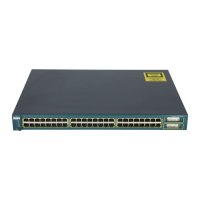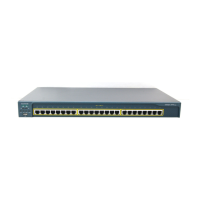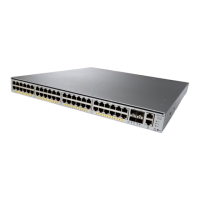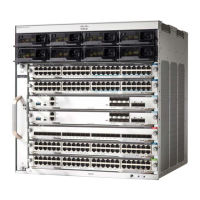30-9
Catalyst 2950 and Catalyst 2955 Switch Software Configuration Guide
78-11380-10
Chapter 30 Configuring QoS
Configuring Auto-QoS
CoS configures each transmit port (the egress port) with a normal-priority transmit queue and a
high-priority transmit queue, depending on the frame tag or the port information. Frames in the
normal-priority queue are forwarded only after frames in the high-priority queue are forwarded.
The switch (802.1P user priority) has four priority queues. The frames are forwarded to appropriate
queues based on the priority-to-queue mapping that you defined.
Egress CoS Queues
The switch supports four CoS queues for each egress port. For each queue, you can specify these types
of scheduling:
• Strict priority scheduling
Strict priority scheduling is based on the priority of queues. Packets in the high-priority queue are
always sent first, and packets in the low-priority queue are not sent until all the high-priority queues
become empty.
The default scheduling method is strict priority.
• Weighted round-robin (WRR) scheduling
WRR scheduling requires you to specify a number that indicates the importance (weight) of the
queue relative to the other CoS queues. WRR scheduling prevents the low-priority queues from
being completely neglected during periods of high-priority traffic. The WRR scheduler sends some
packets from each queue in turn. The number of packets it sends corresponds to the relative
importance of the queue. For example, if one queue has a weight of 3 and another has a weight of 4,
three packets are sent from the first queue for every four that are sent from the second queue. By
using this scheduling, low-priority queues have the opportunity to send packets even though the
high-priority queues are not empty.
• Strict priority and WRR scheduling
Strict priority and WRR scheduling, also referred to as strict priority queueing, uses one of the
egress queues as an expedite queue (queue 4). The remaining queues participate in WRR. When the
expedite queue is configured, it is a priority queue and is serviced until it is empty before the other
queues are serviced by WRR scheduling.
You can enable the egress expedite queue and assign WRR weights to the other queues by using the
wrr-queue bandwidth weight1 weight2 weight3 0 global configuration command.
Configuring Auto-QoS
Note This feature is available only if your switch is running the EI.
You can use the auto-QoS feature to simplify the deployment of existing QoS features. Auto-QoS makes
assumptions about the network design, and as a result, the switch can prioritize different traffic flows
and appropriately use the egress queues instead of using the default QoS behavior (the switch offers
best-effort service to each packet regardless of the packet contents or size and sends it from a single
queue).
When you enable auto-QoS, it automatically classifies traffic based on the traffic type and ingress packet
label. The switch uses the resulting classification to choose the appropriate egress queue.
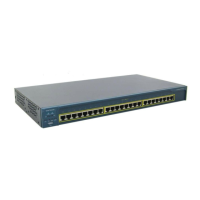
